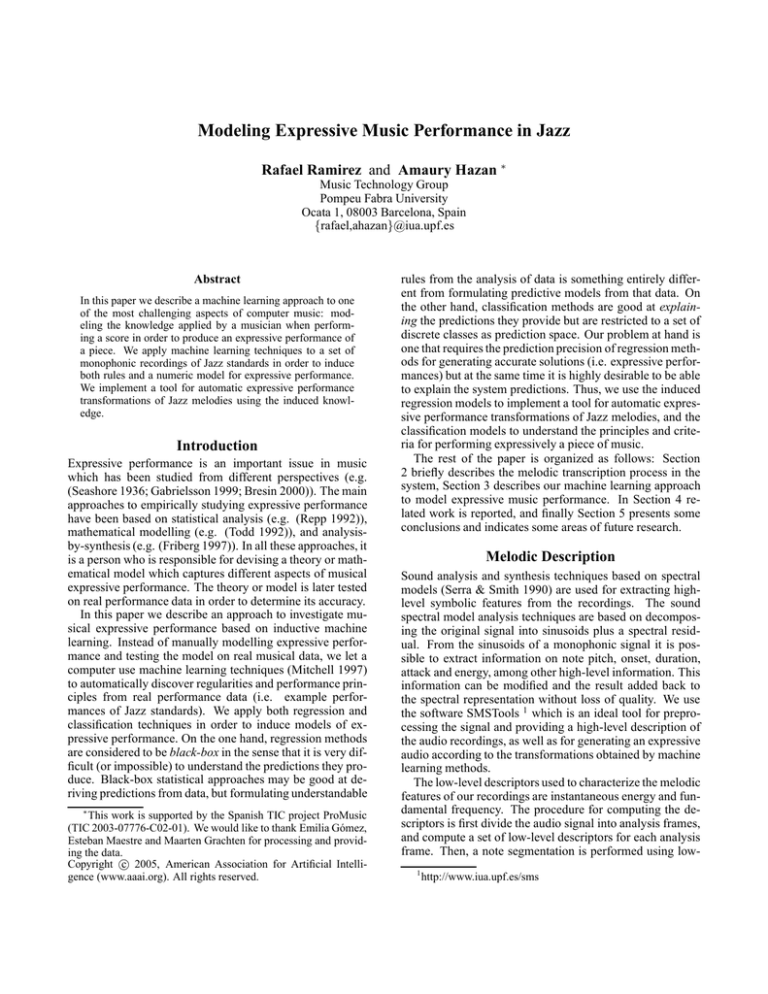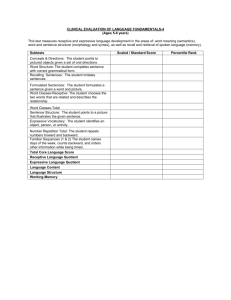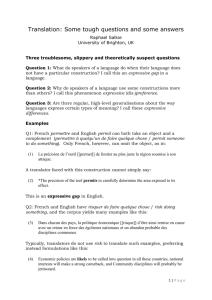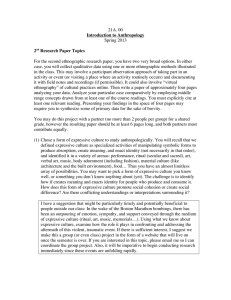
Modeling Expressive Music Performance in Jazz
Rafael Ramirez and Amaury Hazan ∗
Music Technology Group
Pompeu Fabra University
Ocata 1, 08003 Barcelona, Spain
{rafael,ahazan}@iua.upf.es
Abstract
In this paper we describe a machine learning approach to one
of the most challenging aspects of computer music: modeling the knowledge applied by a musician when performing a score in order to produce an expressive performance of
a piece. We apply machine learning techniques to a set of
monophonic recordings of Jazz standards in order to induce
both rules and a numeric model for expressive performance.
We implement a tool for automatic expressive performance
transformations of Jazz melodies using the induced knowledge.
Introduction
Expressive performance is an important issue in music
which has been studied from different perspectives (e.g.
(Seashore 1936; Gabrielsson 1999; Bresin 2000)). The main
approaches to empirically studying expressive performance
have been based on statistical analysis (e.g. (Repp 1992)),
mathematical modelling (e.g. (Todd 1992)), and analysisby-synthesis (e.g. (Friberg 1997)). In all these approaches, it
is a person who is responsible for devising a theory or mathematical model which captures different aspects of musical
expressive performance. The theory or model is later tested
on real performance data in order to determine its accuracy.
In this paper we describe an approach to investigate musical expressive performance based on inductive machine
learning. Instead of manually modelling expressive performance and testing the model on real musical data, we let a
computer use machine learning techniques (Mitchell 1997)
to automatically discover regularities and performance principles from real performance data (i.e. example performances of Jazz standards). We apply both regression and
classification techniques in order to induce models of expressive performance. On the one hand, regression methods
are considered to be black-box in the sense that it is very difficult (or impossible) to understand the predictions they produce. Black-box statistical approaches may be good at deriving predictions from data, but formulating understandable
∗
This work is supported by the Spanish TIC project ProMusic
(TIC 2003-07776-C02-01). We would like to thank Emilia Gómez,
Esteban Maestre and Maarten Grachten for processing and providing the data.
c 2005, American Association for Artificial IntelliCopyright gence (www.aaai.org). All rights reserved.
rules from the analysis of data is something entirely different from formulating predictive models from that data. On
the other hand, classification methods are good at explaining the predictions they provide but are restricted to a set of
discrete classes as prediction space. Our problem at hand is
one that requires the prediction precision of regression methods for generating accurate solutions (i.e. expressive performances) but at the same time it is highly desirable to be able
to explain the system predictions. Thus, we use the induced
regression models to implement a tool for automatic expressive performance transformations of Jazz melodies, and the
classification models to understand the principles and criteria for performing expressively a piece of music.
The rest of the paper is organized as follows: Section
2 briefly describes the melodic transcription process in the
system, Section 3 describes our machine learning approach
to model expressive music performance. In Section 4 related work is reported, and finally Section 5 presents some
conclusions and indicates some areas of future research.
Melodic Description
Sound analysis and synthesis techniques based on spectral
models (Serra & Smith 1990) are used for extracting highlevel symbolic features from the recordings. The sound
spectral model analysis techniques are based on decomposing the original signal into sinusoids plus a spectral residual. From the sinusoids of a monophonic signal it is possible to extract information on note pitch, onset, duration,
attack and energy, among other high-level information. This
information can be modified and the result added back to
the spectral representation without loss of quality. We use
the software SMSTools 1 which is an ideal tool for preprocessing the signal and providing a high-level description of
the audio recordings, as well as for generating an expressive
audio according to the transformations obtained by machine
learning methods.
The low-level descriptors used to characterize the melodic
features of our recordings are instantaneous energy and fundamental frequency. The procedure for computing the descriptors is first divide the audio signal into analysis frames,
and compute a set of low-level descriptors for each analysis
frame. Then, a note segmentation is performed using low1
http://www.iua.upf.es/sms
level descriptor values. Once the note boundaries are known,
the note descriptors are computed from the low-level and the
fundamental frequency values (see (Gómez 2002) for details
about the algorithm). Figure 1 is a snapshot of the SMSTools
software showing the audio recording and some of the lowlevel descriptors extracted from it.
Modeling expressive performance knowledge
in Jazz
In this section, we describe our inductive approach for learning expressive performance rules from Jazz standards performances by a skilled saxophone player. Our aim is to find
note-level rules which predict, for a significant number of
cases, how a particular note in a particular context should be
played (e.g. longer than its nominal duration). We are aware
of the fact that not all the expressive transformations regarding tempo (or any other aspect) performed by a musician can
be predicted at a local note level. Musicians perform music
considering a number of abstract structures (e.g. musical
phrases) which makes expressive performance a multi-level
phenomenon. In this context, our ultimate aim is to obtain
an integrated model of expressive performance which combines note-level rules with structure-level rules. Thus, the
work presented in this paper may be seen as a starting point
towards this ultimate aim.
The training data used in our experimental investigations
are monophonic recordings of five Jazz standards (Body and
Soul, Once I loved, Donna Lee, Like Someone in Love and
Up Jumped Spring) performed by a professional musician at
11 different tempos. In order to discover expressive performance regularities at different tempos we divided the recordings into three groups: nominal, slow and fast. The recordings in the nominal group are performed at the piece nominal tempo (+/- 15%) while the recordings in the slow and
fast groups are respectively performed slower or faster than
the ones in the nominal group. As mentioned before, sound
analysis and synthesis techniques based on spectral models
are used for extracting high-level symbolic features from the
recordings, transforming them and synthesizing a modified
recording.
After the extraction of high-level symbolic features from
the recordings, each note in the training data is annotated
with its corresponding class and a number of attributes representing both properties of the note itself and some aspects
of the local context in which the note appears. Information about intrinsic properties of the note include the note
duration and the note metrical position, while information
about its context include the note Narmour group(s) (Narmour 1990) (see (Ramirez et al. 2004) for a desciption of
the Narmour groups we use), duration of previous and following notes, and extension and direction of the intervals
between the note and the previous and following notes.
In this paper, we are concerned with note-level expressive transformations (in particular transformations of note
duration, onset and energy). For classification, the performance classes we are interested in are lengthen, shorten,
advance, delay, louder and softer. A note is considered to
belong to class lengthen if its performed duration is 20% or
more longer that its nominal duration, e.g. its duration according to the score. Class shorten is defined analogously.
A note is considered to be in class advance if its performed
onset is 5% of a bar earlier (or more) than its nominal onset. Class delay is defined analogously. A note is considered
to be in class louder if it is played louder than its predecessor and louder then the average level of the piece. Class
softer is defined analogously. We have explored different
possible discretization schemes. In particular we have discretized the duration, onset and energy values space in 9
classes according to the degree of transformation. For instance, we have defined 4 classes for lengthen and 4 classes
for shorten (one for same) for different degrees of lengthening and shortening. In this way, we have obtained a set of
finer-grain rules which, in addition to explaining expressive
performances principles in more detail, may be also used to
generate expressive performances. However, for generating
the actual expressive performances in our system, we have
induced predictive regression models (i.e. model trees) for
duration ratio, onset deviation and energy variation (more on
this later).
Using this data we applied the C4.5 decision tree learning
algorithm (Quinlan 1993) and obtained a set of classification
rules directly from the decision tree generated by the algorithm. We also applied the Apriori rule learning algorithm
(Agrawal, Imieliski, & Swami 1993) to induce association
rules and a sequential covering algorithm to induce first order rules. Despite the relatively small amount of training
data some of the rules generated by the learning algorithms
turn out to correspond to intuitive musical knowledge (e.g.
Rule 1 bellow corresponds to the performer’s frequent intention of accentuating a note’s characteristic, in this case the
shortness of the note relative to its neighboring notes). In order to illustrate the types of rules found let us consider some
examples of learned note-duration rules:
RULE1:
prevdur=+3 & nextdur=+3
metrstrenght=weak ⇒ shorten
&
“If both the duration of the previous and next notes are much
longer (i.e. more than three times the duration of the current
note) and the current note is in a weak metrical position then
shorten the current note.”
RULE2: nextdur=-2 ⇒ lengthen
“If the duration of the next note is considerably shorter (i.e.
less than half the duration of the current note) then lengthen
the current note.”
RULE3: next=silence ⇒ lengthen
“if the next note is a silence then lengthen the current note.”
RULE4: stretch(A, B, C, shorten) :succ(C, D), succ(D, E),
context(A, E, [nargroup(p, 1)| F]),
context(A, C, [nargroup(p, 2)| F]).
“Shorten a note n if it belongs to a P Narmour group in
Figure 1: SMSTools showing an audio recording (top), its fundamental frequencies (middle) and spectral peaks of the first
frame (bottom)
second position and if note n+2 belongs to a P Narmour
group in first position”
These extremely simple rules proved to be very accurate:
the first rule predicts 89%, the second rule predicts 68%,
the third rule predicts 87% and the last rule predicts 96%
of the relevant cases. The learning algorithm used for the
rules 1 and 2 was C4.5, rule 3 was obtained by the Apriori
algorithm (in this case the obtained association rules are also
classification rules), and rule 4 was obtained using a sequential covering algorithm.
As mentioned before, for generating the actual expressive
performances in our system, we have induced regression
model trees for duration ratio, onset deviation and energy
variation. We have chosen model trees as a prediction mechanism in our system because it showed the overall highest
correlation coefficient among the regression methods we explored: 0.72, 0.44 and 0.67 for duration ratio, onset deviation and energy variation, respectively (we performed a 10fold cross validation to obtain these numbers). We applied
Weka’s M5Rules algorithm implementation (Witten & Eibe
1999) to generate the model trees. The other methods we explored were linear regression and support vector machines
with different kernels (2nd, 3rd and 4th order polynomial
and radial basis).
For a detailed comparison among the regression methods
we explored see Table 1 (note duration), Table 2 (note onset)
and Table 3 (note energy). In Table 1, Table 2 and Table 3,
C.C refers to the correlation coefficient, A.E to the relative
absolute error, and S.E the root relative squared error.
Algorithm
Linear Regression
LMS Regression
Model Tree Regression
SVM Regression (1)
SVM Regression (2)
SVM Regression (3)
SVM Regression (4)
C.C
0.33
0.29
0.72
0.29
0.48
0.66
0.70
A.E(%)
98.69
95.22
74.89
95.30
89.01
76.65
81.11
S.E(%)
94.39
96.60
69.14
96.15
88.24
75.47
71.23
Table 1. 10-fold cross validation results for duration ratio
Algorithm
C.C A.E(%) S.E(%)
Linear Regression
0.17 101.12
98.41
LMS Regression
0.01
92.50
101.32
Model Tree Regression 0.43
91.51
90.16
SVM Regression (1)
0.14
99.92
98.88
SVM Regression (2)
0.24
89.34
98.18
SVM Regression (3)
0.38
95.41
92.50
SVM Regression (4)
0.44
94.56
90.34
Table 2. 10-fold cross validation results for onset deviation
Algorithm
C.C A.E(%) S.E(%)
Linear Regression
0.27
95.69
96.13
LMS Regression
0.22
87.92
108.01
Model Tree Regression 0.67
66.31
74.31
SVM Regression (1)
0.25
89.28
98.57
SVM Regression (2)
0.47
82.53
89.4
SVM Regression (3)
0.56
75.47
82.95
SVM Regression (4)
0.64
69.28
77.23
Table 3. 10-fold cross validation results for energy variation
Synthesis tool. We have implemented a tool which transforms an inexpressive melody input into an expressive one
following the induced model tree. The tool can either generate an expressive MIDI performance from an inexpressive
MIDI description of a melody, or generate an expressive audio file from an inexpressive audio file. Figure 2 and Figure
3 show snapshots of the system applied to a MIDI performance and the system applied to an audio file, respectively.
In addition to synthesising an expressive performance of a
piece, the tool may be able to provide explanations for the
transformations it has performed. Once a transformed note
is selected requesting an explanation, the tool extracts the
relevant rules generated by the different classification models and present them to the user. This explanations can be of
great interest if the tool is used with padagogical purposes.
Some samples of expressive performances generated by the
system can be found at 2 .
Related work
Previous research in learning sets of rules in a musical context has included a broad spectrum of music domains. The
most related work to the research presented in this paper is
the work by Widmer (Widmer 2002b; 2002a). Widmer has
focused on the task of discovering general rules of expressive classical piano performance from real performance data
via inductive machine learning. The performance data used
for the study are MIDI recordings of 13 piano sonatas by
W.A. Mozart performed by a skilled pianist. In addition to
these data, the music score was also coded. The resulting
substantial data consists of information about the nominal
note onsets, duration, metrical information and annotations.
When trained on the data the inductive rule learning algorithm named PLCG (Widmer 2001) discovered a small set
of 17 quite simple classification rules (Widmer 2002b) that
predict a large number of the note-level choices of the pianist. In the recordings, the tempo of the performed piece
was not constant, as it was in our experiments. In fact, the
tempo transformations throughout a musical piece were of
special interest.
Other inductive machine learning approaches to rule
learning in music and musical analysis include (Dovey
1995), (Van Baelen & De Raedt 1996), (Morales 1997) and
(Igarashi, Ozaki, & Furukawa 2002). In (Dovey 1995),
Dovey analyzes piano performances of Rachmaniloff pieces
using inductive logic programming and extracts rules underlying them. In (Van Baelen & De Raedt 1996), Van Baelen
extended Dovey’s work and attempted to discover regularities that could be used to generate MIDI information derived from the musical analysis of the piece. In (Morales
1997), Morales reports research on learning counterpoint
rules. The goal of the reported system is to obtain standard counterpoint rules from examples of counterpoint music pieces and basic musical knowledge from traditional music. In (Igarashi, Ozaki, & Furukawa 2002), Igarashi et al.
describe the analysis of respiration during musical performance by inductive logic programming. Using a respiration
sensor, respiration during cello performance was measured
and rules were extracted from the data together with musical/performance knowledge such as harmonic progression
2
http://www.iua.upf.es/∼rramirez/promusic
and bowing direction.
Tobudic et al. (Tobudic & Widmer 2003) describe a relational instance-based approach to the problem of learning to apply expressive tempo and dynamics variations to
a piece of classical music, at different levels of the phrase
hierarchy. The different phrases of a piece and the relations among them are represented in first-order logic. The
description of the musical scores through predicates (e.g.
contains(ph1,ph2)) provides the background knowledge. The training examples are encoded by another predicate whose arguments encode information about the way the
phrase was played by the musician. Their learning algorithm
recognizes similar phrases from the training set and applies
their expressive patterns to a new piece.
Lopez de Mantaras et al. (Lopez de Mantaras & Arcos
2002) report on a performance system capable of generating expressive solo performances in jazz within a case-based
reasoning system. As ours, their system focuses on note onset, duration and energy. However, their system is incapable
of explaining the predictions it makes.
Conclusion
This paper describes an inductive approach to learning both
rules and a numeric model for expressive performance from
Jazz standards recordings by a skilled saxophone player. In
order to induce expressive perfromance knowledge, we have
extracted a set of acoustic features from the recordings resulting in a symbolic representation of the performed pieces.
We then applied both classification and regression methods
to the symbolic data and information about the context in
which the data appears. We used the induced regression
models to implement a tool for automatic expressive performance tranformations of Jazz melodies, and we used the
classification models to understand the principles and criteria for performing expressively a piece of music.
Future work: There is future work in different directions.
We are currently using the timbral information of our recordings to extend our models in order to predict intra-note characteristics of an expressive performance. We plan to increase the amount of training data. Increasing the training data, extending the information in it and combining it
with background musical knowledge will certainly generate
a more complete model. As mentioned earlier, we intend
to incorporate structure-level information to obtain an integrated model of expressive performance which combines
note-level knowledge with structure-level knowledge.
References
Agrawal, R.; Imieliski, T.; and Swami, A. 1993. Mining association rules between sets of items in large databases. In
SIGMOD ’93: Proceedings of the 1993 ACM SIGMOD international conference on Management of data, 207–216.
ACM Press.
Bresin, R. 2000. Virtual Visrtuosity: Studies in Automatic Music Performance. Ph.D. Dissertation, Kungliga
Tekniska hgskolan.
Figure 2: Expressive performance generator tool showing the inexpressive MIDI description of Body and Soul and the transformed expressive MIDI description
Figure 3: Expressive performance generator tool showing the inexpressive audio file of Body and Soul and the transformed
expressive audio file
Dovey, M. 1995. Analysis of rachmaninoff’s piano performances using inductive logic programming. In Proceedings of European Conference on Machine Learning.
Friberg, A. 1997. A Quantitative Rule System for Musical Performance. Ph.D. Dissertation, Kungliga Tekniska
hgskolan.
Gabrielsson, A. 1999. The performance of Music. Academic Press.
Gómez, E. 2002. Melodic Description of Audio Signals
for Music Content Processing. Ph.D. Dissertation, Pompeu
Fabra University.
Igarashi, S.; Ozaki, T.; and Furukawa, K. 2002. Respiration reflecting musical expression: Analysis of respiration
during musical performance by inductive logic programming. In Proceedings of Second International Conference
on Music and Artificial Intelligence.
Lopez de Mantaras, R., and Arcos, J. 2002. Ai and music
from composition to expressive performance. AI Magazine
23(3).
Mitchell, T. 1997. Machine Learning. McGraw-Hill.
Morales, E. 1997. Pal: A pattern-based first-order inductive system. Machine Learning 26.
Narmour, E. 1990. The Analysis and Cognition of Basic
Melodic Structures: The Implication Realization Model.
University of Chicago Press.
Quinlan, J. R. 1993. C4.5: Programs for Machine Learning. Morgan Kaufmann Publishers Inc.
Ramirez, R.; Hazan, A.; Gmez, E.; and Maestre, E. 2004.
Understanding expressive transformations in saxophone
jazz performances using inductive machine learning. In
Proceedings of Sound and Music Computing ’04.
Repp, B. 1992. Diversity and commonality in music performance: an analysis of timing microstructure in schumann’s ‘traumerei’. Journal of the Acoustic Society of
America 104.
Seashore, C. 1936. Objective Analysis of Music Performance. University of Iowa Press.
Serra, X., and Smith, S. 1990. Spectral modeling synthesis:
A sound analysis/synthesis system based on a deterministic
plus stochastic decomposition. Computer Music Journal.
Tobudic, A., and Widmer, G. 2003. Relational ibl in music
with a new structural similarity measure. In Proceedings of
the International Conference on Inductive Logic Programming.
Todd, N. 1992. The dynamics of dynamics: a model of musical expression. Journal of the Acoustic Society of America 91.
Van Baelen, E., and De Raedt, L. 1996. Analysis and prediction of piano performances using inductive logic programming. In Proceedings of International Conference in
Inductive Logic Programming.
Widmer, G. 2001. Discovering strong principles of expressive music performance with the plcg rule learning strategy. In Proceedings of the 12th European Conference on
Machine Learning (ECML’01).
Widmer, G. 2002a. In search of the horowitz factor: Interim report on a musical discovery project. In Proceedings
of the 5th International Conference on Discovery Science
(DS’02).
Widmer, G. 2002b. Machine discoveries: A few simple,
robust local expression principles. Computer Music Journal.
Witten, I., and Eibe, F. 1999. Data Mining, Practical Machine Learning Tools and Techniques with Java Implementation. Morgan Kaufmann Publishers Inc.



